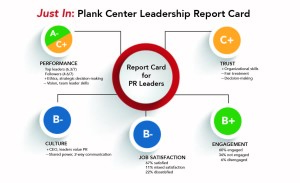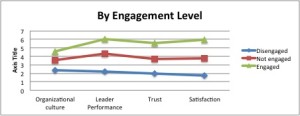The Plank Center Celebrates with a Leadership Report Card
Posted: July 23, 2015, 11:20 a.m.
by Mary Claire Hunter.
In 2015, the Plank Center for Leadership in Public Relations reached its 10th year of developing and recognizing outstanding, diverse leaders to advance ethical public relations education and practice. The Plank Center recently created a Leadership Report Card for PR leaders and their employees as a part of its year-long anniversary campaign, celebrating a decade of research and advocacy for the field.
The survey was sent to thousands of top PR professionals internationally, and results were grouped into five categories, three of which were organizational culture, job satisfaction and work engagement. With this study, the Plank Center proves that even leaders can’t escape the grading scale by assigning each of these categories a letter grade based on mean scores.

While job engagement scores in the field were high — earning a B+ on the Report Card — job satisfaction came in on the lower side with a B-. However, job satisfaction is always difficult to judge. Satisfaction within a job often depends on an employee’s life outside of work or the employee’s opinions of and relationship with the supervisor.
Having engaged employees within an organization yields more productivity and, therefore, profit. Kevin Kruse, bestselling author and contributing writer for Forbes, defines employee engagement as the “emotional commitment the employee has to the organization and its goals.” An employee is not invested unless he or she buys into the mission of an organization.
However, work engagement and job satisfaction are not always indicators of each other; there are levels of commitment that satisfied employees wouldn’t reach, but engaged employees would. Kruse writes that a satisfied employee would not go the extra mile without being asked, but an engaged employee would.
Dr. Bruce Berger, research director of the Plank Center, believes that encouraging employee engagement is one of the most important responsibilities PR leaders and executives have to those they manage. It is no mystery that employees who feel valued and appreciated tend to be more satisfied and engaged.
There are things a boss can do to promote more satisfaction and engagement among employees. These include basic actions any human should have toward others, such as showing an interest in an employee’s personal and family life and being a good listener. Other ways are more job-related, such as giving routine performance reviews, providing training and development within the company, and giving tasks tailored to what a specific employee might enjoy.
“Being a really good boss in these regards builds trust, which also influences engagement,” Berger said. “When I was at Whirlpool, I tried to do all these things.”

So how does a student secure a job or internship in which he or she will feel engaged and satisfied? It’s all in the culture of the company.
Jacquie McMahon, a recent UA advertising and public relations graduate and now assistant account executive at Ogilvy Public Relations, said that company culture was an aspect she considered during her search for a job. (link)
“Company culture is crucial to talk about during the interview process and definitely a deciding factor,” McMahon said. “It’s a way to differentiate among the companies you apply to, because every company will have different talking points. Try to find somewhere you can explore your own passion points.”
Some companies offer programs to their employees that will trigger these “passion points” and increase engagement. Whether it be providing each employee with a free membership to a gym, establishing volunteer efforts with a local philanthropy, or sponsoring a company team in a sports league, programs that show co-workers existing happily outside of the office reveal an effective leader interested in employee engagement and satisfaction.
During McMahon’s first day of training, a co-worker introduced her to an existing program within Ogilvy PR called Take 5. “It’s the social and philanthropic arm of OPR, and the meetings are always fun,” McMahon said. “There are also networks within Ogilvy & Mather as a whole, and I’m excited to get more involved with those and meet more people in our office.”
Berger advises students to seek a company that also has a good culture for communication: one that promotes open and two-way communication, as well as a positive climate where employees feel able to speak up without fear of penalty. It’s important to ask direct questions if you have concerns about engagement, job satisfaction and company culture. But most of all, trust your gut instincts. Berger said company culture should always be an important factor to consider, if a student has multiple offers on the table.
The Leadership Report Card brings the concepts of job satisfaction, work engagement and company culture to the forefront of the minds of PR students, researchers and executives. The Plank Center plans to conduct this leadership survey every two years, in order to monitor improvements or stalls within our industry. The continued findings will benefit the PR industry as a whole.
“The point of the survey is: let’s identify the gaps, and then let’s do something about them,” Berger said.




